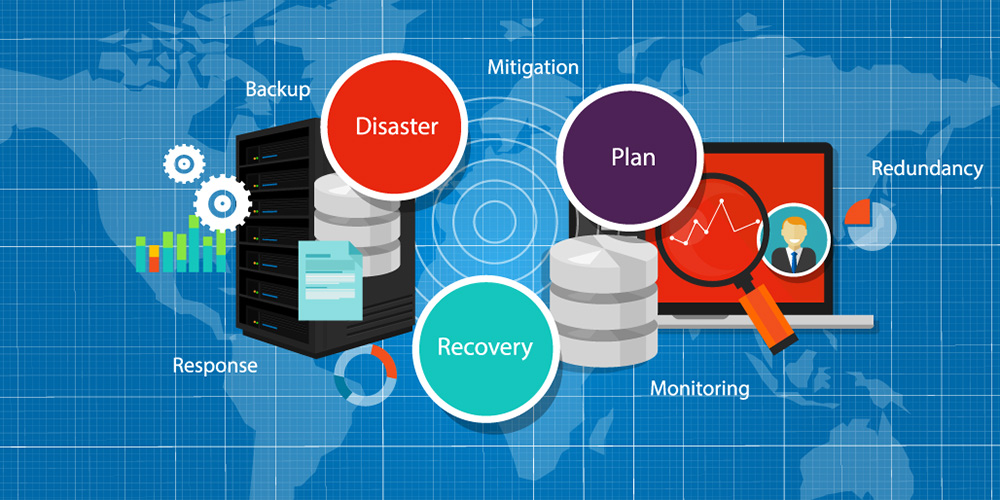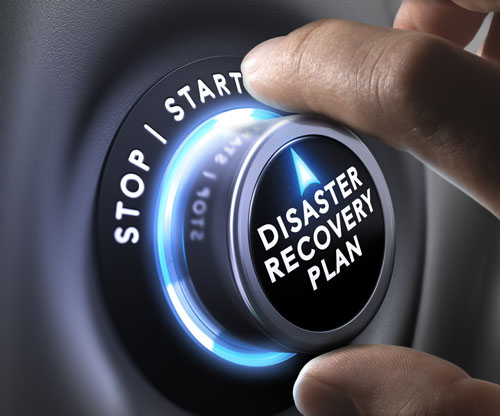
Apr 17, 2019 | SMB Technology, SMB Technology, SMB Technology, SMB Technology, Technology News
With disasters–natural and manmade–in the news, preparedness in the form of a business continuity plan is vital. Disaster recovery, or the ability of a business to continue running during and after a disaster, is a key part of business continuity. Read on to learn more about developing a plan to keep your business operating even when things go wrong. The Importance of Being Prepared During a Disaster Recovery Scenario According to an article by CompTIA, 40% of businesses do not reopen after a disaster. A quarter (25%) of unprepared businesses fail within one year. A disaster recovery (DR) plan enables businesses to respond, not just react, in the event of a disaster. It is a subset of an overall plan, and has to do with immediate access to systems and applications–and their associated data. The company can stay in business, without loss of revenue or reputation. Creating a BC/DR Plan: Questions to Consider The first question to consider in developing a DR plan is determining which systems are mission-critical, most crucial to conducting business. Some, such as communications, important applications and data storage, are the most essential; others can wait until the disaster is over. How much downtime can your business handle, without loss of revenue or reputation? With regard to data storage, consider whether it should be kept on-premises or be stored remotely in a data center. Is the network redundant; that is, if one section goes down, can another take up the load in its place? For data storage, the cloud can also be a good option, and using the cloud has become a trend in recent...

Apr 9, 2018 | SMB Technology, SMB Technology, SMB Technology, SMB Technology
We hear in the news every day about natural disasters such as fires, floods, storms and even earthquakes, and know the damage they cause. But what about the potential consequences for your business? What if your business stays closed for a period of time, and loses revenue because your information systems are unavailable? Or if a cyberattack occurs that results in a data breach that compromises your business’s reputation? Read on to learn more about how to make a disaster recovery and business continuity plan. The Importance of Having a Plan Disaster Recovery and Business Continuity consists of processes used to prepare for disruptive events, whether natural or man-made. Having a plan will help you know what to do and how to do it in events that can result in downtime for your business. Your plan can prevent loss of revenue, as well as loss of reputation. It can even help keep your business in business. Assessing Your Risks Think first of your mission-critical applications–your phone system, email system and maybe even processing orders. Consider how much downtime you can risk, having these systems out of commission. Tabulate potential overhead, loss of employee wages and revenue over the course of hours, days or weeks. Systems needing to take priority are the ones that keep your business running smoothly, keeping revenue flowing and employees productive. Other applications, including shared files, can be backed up and retrieved. Along with mitigating financial risk, a plan can guard against potential damage to your business’s reputation resulting from a data breach, or being unavailable in the event of a natural disaster. Implement, Test and...
Sep 12, 2017 | SMB Technology, Technology News
Recent Hurricanes Harvey and Irma, along with major earthquakes in Mexico, remind us how vulnerable we can be to disasters, and underscore the importance of data protection. As businesses depend on access to a range of systems–including call center, communications and collaboration application, customer management, and more–having a solid data protection plan can help you in a disaster recovery scenario. Now more than ever, a range of options exist to help maintain business continuity. Here are a few options to consider. Review Your Data Protection Plan Key to your data protection plan is identification of mission-critical systems. The most important systems should be redundant, with the ability for failover in the event of a disaster. Your data centers and failover options should be geographically dispersed and on different network backbones. This can minimize downtime and get you back up and running sooner. Having your data backup available in Cloud Storage can help you recover other important files and application data if you lose access to your on-premise systems. SD-WAN for Business Continuity Software-defined wide area networks (SD-WAN) can also provide you a highly reliable and redundant network. Having the ability to switch Wide Area Networks using SD-WAN as an alternative to more costly MPLS solutions can ensure connectivity during a natural disaster. What’s more, Software-Defined Wide Area Networking can save you money in the long run by giving you the flexibility of a multi-carrier solution. Software as a Service for Disaster Recovery More businesses are turning to the Cloud for a range of applications–hosted email, Voice over IP (VoIP), Call Center, and others–to keep communications flowing during a...
Jul 18, 2017 | SMB Technology, Technology News
Reputation Management is a hot topic in the boardroom these days. Having a solid business continuity plan could make or break your company’s ability to survive a data breach or other systems failure that could tarnish your hard-earned reputation. Company news about data loss, systems downtime and other unplanned interruptions occur with regularity. According to technology research firm Gartner, a business that has a catastrophic data event has a two-year survival rate of just 6%. Surprisingly, your company can avoid these scenarios by having a solid BC/DR Plan. It is no surprise that recent research by MarketsandMarkets forecasts the spend on DR as a Service (DRaaS) to grow from $1.68 Billion in 2017 in revenue to $11.11 Billion by 2020. Read on to find out how a Business Continuity Plan could save your business. Understand Your Business Continuity Risk and Exposure A great place to start with Business Continuity planning is a review of your company policies and procedures. Your business continuity policies should — in addition to identifying the technical standards for managing your company’s applications, data, and related infrastructure — should identify acceptable risk, what your employees will do in a disaster recovery scenario, and identify any compliance requirements. It is important to understand what information is most important and to consider the risks of suffering a data loss. What would be the impact to your revenue, productivity and reputation? If you could not access your information, or it was subject to data breach, how may that impact your customers’ trust and your business’s reputation? An Ounce of Planning is Worth a Pound of Cure Ensure you...
Apr 12, 2017 | SMB Technology, SMB Technology, SMB Technology, Technology News
Does your business have a backup and disaster recovery plan? Businesses of any size should know which applications–and their associated data–they rely on and what the cost of interruption would be in the event of an unintended disruption. Cyber Threat, natural disasters, and systems failures may impact your business; however, human error is said to be the top cause of data breach (58%), ahead of technology errors. To avoid unnecessary downtime, here are some questions to ask to help assess your backup and disaster recovery plans. Assess the Risks of Data Loss and System Downtime With Backup and Disaster Recovery there is always a balance between cost and risk. To allocate your technology spending, it is important to focus on your areas of exposure. Maybe your business relies heavily on an order-processing and invoicing system, or perhaps a manufacturing and inventory control system. If these systems go down you may lose revenue and productivity from employee idle time. You may also have intellectual property that is important to your business. What would be the consequence if this data was lost and could not be recovered? You may also have compliance exposure, if you suffered a breach of privacy or other data that should be encrypted was exposed. Assessing your risks and ranking the exposure is an important step to evaluate your backup and disaster recovery plan priorities. Not all Backup Plans are Alike For systems you rely on heavily, you may consider having an offsite failover system in the event of a data loss. This can minimize your downtime by enabling you to rapidly cut over to a...




